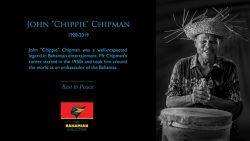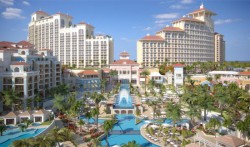The $76 million Grand Bahama Film Studios is hoping “to move forward pretty quickly” with the next stage of its development, construction of a 141-room hotel, as Disney prepares to begin two-and-a-half months of filming at the site tomorrow for Pirates of the Caribbean II and III.
With “everything in place” for Disney, Paul Quigley, a principal of Gold Rock Creek Enterprises, the holding company for the film studios, yesterday told The Tribune that the firm was now “starting up on our next phase”.
He explained that the developers had “a little more time” to prepare for the hotel’s construction, as it had to rush to completion construction of the water tank, where the Pirates of the Caribbean II and III films will be shot, due to Disney’s tight production schedule.
“We have all our initial designs, and are putting together a package for the Government to review,” Mr. Quigley said.
Much logistical work had already been done for the 141-room property, and he added: “We are moving forward and have a lot of people in place pulling together different aspects, and once we are clear on the exact location of the hotel and get a preliminary environmental impact assessment, hopefully we’ll be moving forward with that pretty quickly.”
The Government has previously said that filming Pirates of the Caribbean II and III at the Bahamas Film Studios would inject between $30-$40 million into the Grand Bahama economy, providing that island with a much-needed shot in the arm as it continued its recovery from the September 2004 hurricanes.
Mr. Quigley yesterday revealed that the Disney film crews had booked a total of 65,000 room nights on Grand Bahama for shooting the film, and were spread between Our Lucaya’s Sheraton and Westin properties, plus Pelican Bay. Separately, The Tribune has been told that Disney film crew members are taking up at least 400 rooms at the Sheraton alone.
Gold Rock Creek itself was still employing 70 construction workers on developing the studio infrastructure, and Mr. Quigley said the company had been buying much of its building materials from suppliers on Grand Bahama.
“We’ve been very pressed and it makes life a lot easier by buying locally,” Mr. Quigley said. “We have accounts with all the suppliers in Freeport who are constantly supplying materials to the site.” The Bahamas Film Studios had also been “using a lot” of small Bahamian contractors, such as electricians.
The Disney contingent for Pirates of the Caribbean II and III numbered about 400, and Mr. Quigley said the company had “hired a significant number of Bahamians in so many areas”, including extras and production assistants. Many of Disney’s departments heads had already spent three weeks on Grand Bahama doing preparatory work.
He explained that the Disney production would further accelerate development of an indigenous film industry in the Bahamas, as those, hired, for Pirates of the Caribbean II and III would learn skills through on-the-job training that would be especially attractive for other productions the Bahamas Film Studios was looking to attract.
Effectively, the Pirates of the’ Caribbean II and III films will be the gateway for developing a film and television production industry in the Bahamas that “can be counted on by other companies”.
Mr.. Quigley said: “Producers will come to us for pictures down the road, and say: `The Bahamas: What do you have to offer there? ‘ Does anyone have any experience?’ The more people you can put to them, the less people they have to bring in, and that makes it much more interesting for them.
“The Disney, machinery will not only be training people, but have them qualified and available for the next production. You learn far more by being there and working with professionals than in school. There’s definitely great opportunities for those interested in a career.
“If we can maintain some kind of consistency of production, it will keep these people employed and help develop an indigenous industry a little quicker.”
The Bahamas Film Studios has not booked any other productions for after Pirates of the Caribbean II and III is completed, as it wanted to give Disney some flexibility to complete everything it needed to do.
“We’re still looking at other movies, and once we get finished shooting for Disney, we’ll be following up on other leads we’ve been looking at,” said Mr. Quigley.
“There’s an incredible amount of interest, but we’re not in a position to give a schedule yet.”
It has taken Mr. Quigley and the Bahamas Film Studios some five-and-a-half years to get to this point, having begun negotiations on getting the project approved under the former FNM government. It was the current administration that signed the Heads of Agreement for the development, one of the first it agreed upon taking office.
“It’s been a long haul, but it’s certainly been all worthwhile and it’s wonderful to see it all happening,” Mr. Quigley said.
Gold Rock Creek Enterprises had earlier this year taken out a $10 million construction loan to finance completion of Phase I development at the Bahamas Film Studios, which included the water tank – the world’s largest.
News of the loan was, contained in a statement from Ashby Corporation, the Bermuda-registered parent for Gold Rock Creek Enterprises.
Source: Neil Hartnell, The Tribune



